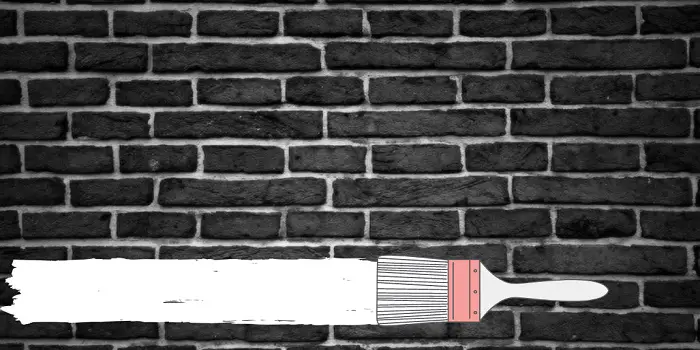
Not everyone wants to prime their walls, and many DIYers may not even realize it’s an option.
However, priming your walls lets, you start with a much better base; it will smooth out color imperfections from patching, conceal stains that could bleed through lighter colors, and neutralize darker colors when you want to make a color change.
When the wall you want to paint is currently black or another dark color such as red, you will want to prime the wall before applying the new color.
This is because the black will bleed through and modify your new color; otherwise, you will have to apply many more costs, which takes time and money, and you’re not guaranteed it will work.
What's Here in the Article:
What Primer is Best for Painting Over Black Paint?
Picking the right primer for your project will be crucial in saving you time and money and ensuring you get the new color exactly as you had imagined it.
But first, you’ll want to sand down the old surface and ensure it’s completely clean before applying any primer.
When picking the primer, you’ll want to choose a high-quality version, not the cheapest possible option.
Find one with a high level of titanium dioxide as that’s the actual component doing the work to block out the original color.
Consider what kind of room you’re working in. For example, if you’re in a bathroom, you may want to get a primer with mold-resistant options.
You’ll also want to decide on which color primer to use, and that can depend on what color you want to end up with on your walls.
Painting light colors over black paint
When trying to transition from black paint to a lighter color such as white, beige, or cream, then you’ll want to go with a white primer.
A white primer should allow you to half the amount of paint you need when moving to this color.
If you’re going for a slightly darker color but still reasonably light, such as pinks, soft greens, or oranges, you’ll want a very light grey primer; otherwise, a white primer may shine through too much and cause your color to be too washed out.
An added tip is to add a few drops of your final paint color to the primer and mix it in.
Mixing the color with the primer will give you a much better finish and as close to your intended color as possible.
Painting dark colors over black paint
If you’re trying to go from a straight black wall to something different but still reasonably dark such as dark green, dark grey, bright pink, or similar darker or bright colors, you’ll want to use a dark grey primer.
Using the dark grey will cut down the number of coats you need anywhere from 8 down to 3, which is a huge time saver.
Going with a dark grey is also a good option if you’re going from a very light color or bright white wall to a darker color.
It makes the transition must easier and cuts out a lot of the brightness that could bleed through.
Again, the entire point of primer is to save you time by blocking a lot of the color there already.
Will a Paint-Primer Combo Work Over Black Paint?
Often you can buy a combo paint-primer in one, which can be effective in some situations.
However, remember that primer and paint provide two different jobs, so combining anything like that may not get the best option for priming or painting.
If you’re painting over black paint and going with black again or a very dark color, it’s possible it will work.
However, black is a very strong color that will bleed through and potentially change the color to be darker than what you want if the primer-combo isn’t doing an adequate job.
Paint-primer combos are just thicker versions of paint, and they aren’t actually primers in most situations.
So, the benefits you would have gotten from a good primer will be lost, even if you end up getting the color you want in the end.
What Primer Color is Best if I Am Painting Over Red Paint?
Painting over a red wall is notoriously tricky and requires special attention and some extra work to ensure the red doesn’t bleed through to your new color.
Use a water-based sealing primer with a color closest to your new paint color to minimize the chance of bleeding through.
In many cases, this will mean using a grey primer and would require at least two coats to cover your red wall.
Because red is a tricky color to handle, it may not be ideal to use paint-primer combo options.
Otherwise, you may still get bleed-through later on.
Some people may want to save money or simply not understand the job of a good primer when painting.
So, take some time to understand precisely what primer does and the benefits you get from it.
You may pay a little more upfront by buying a specific primer, but you’ll be able to block out past colors easier, use less paint in the long run, and have a better surface to paint a wall with defects or water damage.
Of course, the most significant benefit, in the long run, is that you can ensure the paint adheres to the wall correctly and doesn’t start peeling away.
Share the post "What’s the Best Primer Color to Use for Black Paint?"

Douglas Becker (aka Painter Doug) has over twenty years of experience as a painter in Adkins, Texas. At present, he resides in Florida with his family.
From painting multi-storeyed houses, condos, and apartments to large commercial buildings and small offices, he had served various customers in areas not only in Adkins but also in Southwest Florida, Sarasota, Naples, and many more. To know more about him check here.




